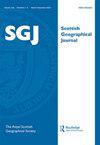Traps, apps and maps: to what extent do they provide decision-grade data on biodiversity?
IF 2
4区 社会学
Q2 GEOGRAPHY
引用次数: 0
Abstract
ABSTRACT Ecosystem services arising from the restoration of natural capital are now increasingly recognised as environmental opportunities and monetised, with international climate negotiations focussing on the need for investment into natural capital, and the finance sector pledging to invest. The finance sector has called for decision-grade, asset level data about nature projects in order to facilitate their reporting to investors. This paper offers a case study of novel digital data collection methods used to establish a baseline of faunal biodiversity in a Scottish nature-restoration project on the Bunloit estate which has secured private natural capital investment. Digital camera traps, acoustic sensors with eDNA samples and apps were used to create digital maps to ensure annual survey replication, and citizen scientist engagement. The results were classified by both professional ecologists and citizen scientists. We discuss how the digital data gathered through traps, apps and maps in the case study can be qualified as decision-grade data, according to the Taskforce for Nature-based Financial Disclosure’s specification. We conclude that decision-grade biodiversity data may be produced by practitioners, with limited resources, and make recommendations for data collection and governance methods to ensure nature restoration projects generate decision-grade data for ecosystem services markets.陷阱、应用程序和地图:它们在多大程度上提供了生物多样性的决策级数据?
摘要自然资本恢复产生的生态系统服务现在越来越被视为环境机遇并被货币化,国际气候谈判的重点是对自然资本的投资需求,金融部门承诺进行投资。金融部门呼吁提供有关自然项目的决策级资产级数据,以便于向投资者报告。本文提供了一个新的数字数据收集方法的案例研究,该方法用于在Bunloit庄园的苏格兰自然恢复项目中建立动物生物多样性的基线,该项目已获得私人自然资本投资。数码相机陷阱、带有eDNA样本的声学传感器和应用程序被用于创建数字地图,以确保年度调查的复制和公民科学家的参与。这些结果由专业生态学家和公民科学家进行了分类。根据基于自然的财务披露工作组的规范,我们讨论了如何将案例研究中通过陷阱、应用程序和地图收集的数字数据定性为决策级数据。我们得出的结论是,决策级生物多样性数据可能由从业者在资源有限的情况下生成,并就数据收集和治理方法提出建议,以确保自然恢复项目为生态系统服务市场生成决策级数据。
本文章由计算机程序翻译,如有差异,请以英文原文为准。
求助全文
约1分钟内获得全文
求助全文
来源期刊

Scottish Geographical Journal
GEOGRAPHY-
CiteScore
1.80
自引率
20.00%
发文量
19
期刊介绍:
The Scottish Geographical Journal is the learned publication of the Royal Scottish Geographical Society and is a continuation of the Scottish Geographical Magazine, first published in 1885. The Journal was relaunched in its present format in 1999. The Journal is international in outlook and publishes scholarly articles of original research from any branch of geography and on any part of the world, while at the same time maintaining a distinctive interest in and concern with issues relating to Scotland. “The Scottish Geographical Journal mixes physical and human geography in a way that no other international journal does. It deploys a long heritage of geography in Scotland to address the most pressing issues of today."
 求助内容:
求助内容: 应助结果提醒方式:
应助结果提醒方式:


